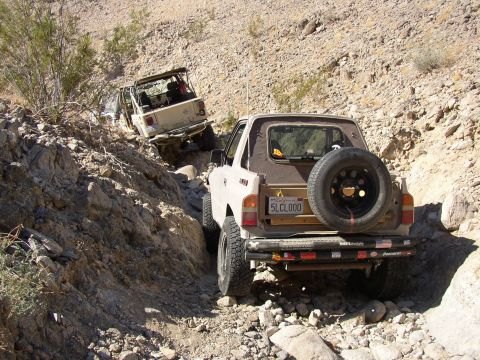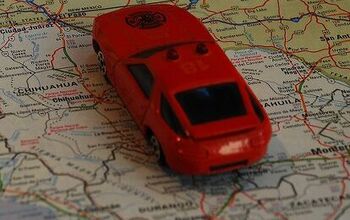New Or Used: Making A Run For The (Brazilian) Border Edition
Jonatas writes:
I’m getting serious about taking a little road trip. Something I’ve long wanted to do. I want to drive from my current home in S. Florida to my hometown in Brazil, hopefully seeing amazing places and meeting amazing people along the way. Since it is a road trip, having the right car/truck is the most important thing to have. I’m looking for something relatively cheap, reliable, economical, and somewhat common in most countries to make for easier maintenance and attract less attention. I don’t think I’ve yet found anything that checks off all the boxes but I keep finding myself looking at late 80’s, early 90’s Toyota 4Runners as they’re sold under the Hi-Lux moniker in most latin american countries. I’ve also looked at Subaru Outbacks from the 90’s but reliability seems to be an issue as well as parts availability. Land Rover Defenders are either too old or expensive. Any other possible vehicle suggestions?
Sajeev answers:
Buying a vehicle in America really narrows down your choices. Sedans, Wagons, Crossovers, and pretty boy trucks are unacceptable and might put your life at risk. So you only have a couple of choices, I am torn between the Toyota Tacoma/4Runner and the Ford Explorer/Ranger. I would like to recommend the Chevy S-10, but I’m unsure of parts availability south of the border. The Ranger wins for me because of the lower asking price, availability, and relative ease of repair. But the Toyota is a better choice once you leave Mexico…I don’t know how US-spec Ford friendly Central and South America are, should you have a breakdown. I mean will have a breakdown.
Whatever you buy, it will need new rubber (tires, belts, hoses), a tune up, heavy-duty shocks (unless you like unnecessary pain), a brake job and fresh engine oil/coolant, at the bare minimum. Good luck, and don’t be afraid to chicken out by flying the friendly skies in lieu of a life-threatening road trip.
Steve answers:
Forget about a car. You need to visit Farago’s site and figure out the right firearm. You have to go through Mexico, Guatemala, Honduras, Nicaragua, Costa Rica, Panama, Colombia, Peru, Bolivia and Argentina to get to Brazil. A few of these places are safer than Florida. The others are just barely safer than Detroit. Actually that’s not entirely true since drug wars, carjackings, kidnappings and martial law are painful realities in many of these countries.
I would buy an older VW Golf from the mid-90’s. Replace the Golf name with ‘Caribe’ on the back. Get everything in tip top shape and make sure you carry two spares, oil, coolant and some extra gas. If you must have something more Jeep like I would consider a 4WD Tracker or Vitara/Sidekick hardtop. Not because they are particularly worthy in any way. But probably because by the time you get to Costa Rica, you may be all too ready to unload the car and take a quick flight. Small 4WD vehicles go for a very healthy premium in Central America. You can take a four figure profit. Fly to Rio. Enjoy the sights and relax.
TTAC’s voice of reason in Brazil, Marcello Vasconcellos, answers:
Hi, I hope you have a nice safe trip! If you’re going to drive all the way from the US into Brazil, I’m guessing you are going to via Mexico, Central America, Colombia, Peru, Bolivia and then into Brazil. This is the most common route as driving from Colombia into the Brazilian Amazon is very difficult. Roads are almost non-existent and the infrastructure simply isn’t there.
As to type of vehicle a pickup or SUV is probably the way to go, though if you stick to the main roads a 4×4 system is not really needed. In Mexico, Central America, Colombia, Peru and Bolivia, probably any Japanese make will blend in. In Brazil however, most Japanese brands are unknown. If you want to blend in, a Toyota Hilux seems like a good idea. But keep your mind open and realize a Nissan Pathfinder or Frontier are also well-known down here and there are Nissan dealerships in most major towns. Also think of a Ford Ranger. In Brazil they’re a dime a dozen. In fact when Ford started selling them down here they were imported from the US and don’t seem to be any worse for wear. Finally, consider a Mitsubishi Montero (sold in Brazil as Pajero, though that’ll will get you some strange looks in the Spanish speaking countries).
Bear in mind that all of these trucks are considered luxury cars in Brazil. All, no matter how old, will draw eyes. Especially if they run on diesel. Diesel would probably be the engine to choose as any road side mechanic will have taken a crack or two at this kind of engine at one time or another (results though will vary). You’ll also not have any trouble in Brazil where cars run on a veritable cocktail of fuel known as Brazilian gasoline. In it, ethanol content runs anything between 19 and 27 percent. Legally. IF you choose a gasoline car, remember that.
Now, thinking out of the box and if you are freakishly worried about blending in, just buy any Ford, VW or Fiat sedan or station wagon. In Mexico. Just make sure they are also available in Brazil. They’ll call no undue attention. I’ve heard that cars there are not so expensive. Are you going alone or just a spouse¿ Any Fiat Strada or Volkswagen Saveiro will also work out fine.
Hope to have helped!
Need help with a car buying conundrum? Email your particulars to mehta@ttac.com, and let TTAC’s collective wisdom make the decision easier… or possibly much, much harder.
More by Sajeev Mehta and Steve Lang
Latest Car Reviews
Read moreLatest Product Reviews
Read moreRecent Comments
- Funky D There are WAY too many of what my youngest son calls grayscale (white, black, silver, gray) out there.I will pick literally ANY color (including that baby puke yellow found on new Chevy crossovers) over a grayscale color. But if every car I had was arrest-me red, I'd be find with that.What happened to the 60s~80s when you could choose from a pretty rich color palate when placing your new car order?
- Tassos Jeep again proving they stand behind freedom. The freedom to choose the fuel you use. I’ll take one in ”Right to express myself freely” pink.
- Jeff Good move on Cadillac's part. Not everyone is ready for an EV it will take more time to expand the charging infrastructure and more affordable EVs.
- 3-On-The-Tree I was never a fan of the newer dodge products but it’s still a shame that all the OEM’s are moving away from V8’s to turbo V6 and V4’s all in the name of emissions and better mpg.
- FreedMike I like the idea of EVs, but the idea that they're going to achieve 100% market penetration was a fantasy to begin with. Also worth noting; Cadillac is on track to sell well over 20,000 Lyriqs this year. Not too shabby. https://www.coxautoinc.com/wp-content/uploads/2024/04/Q1-2024-Kelley-Blue-Book-Electric-Vehicle-Sales-Report.pdf


































Comments
Join the conversation
Being Panamanian and having lived in Colón until around the age of 10 and been back to visit a handful of times I feel like I should chime in. Also, my parents still live in Panama (Panama City) and rock a 2006 Accord 4-cyl and have had exactly zero problems getting it serviced if that is meaningful. Right. I will say almost any simple Japanese rig should be serviceable, but the Euros do tend to stick out, though. Older garden variety USDMs don't turn heads and are easy to get fixed, but I didn't see too many Chrysis-mobiles outside of Jeep Wanglers down there. If you were to get a Wrangler - the older the better. I imagine they might stick out once you leave the relative affluence of Panama City and go further south. If it were me, a mid to late 90s Taco/4runner or Trooper/Pathfinder might be my bet. Oh, this might be informative also; last year around this time I did see a mid-2000s Explorer with Ecuadoran tags in Delaware. Go fig.
I was sitting in a cafe in Belize last month when I struck up a conversation with a fellow who had just driven there from Texas. Now- this guy was hispanic and a fluent Spanish speaker. The plates on his car got him pulled over SIX times while driving through Mexico- with each police officer or Federale demanding 500 American Dollars to avoid being dragged down to the station. At no time did he feel unsafe- but his trip was slowed down considerably. In addition, despite being skilled in both Spanish and negotiating in general, he averaged 75-85 dollars final bribery price for each officer- for a rough total of 500 USD in bribery to drive through the country. Had he been a gringo with Espanol muy mal, it would have been a lot pricier than that. This information is about 6 weeks old and it was just one guy's story, so take it for what it is worth.